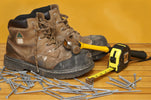
How Much Do Steel Toe Boots Weigh?
, by Ed Stone, 6 min reading time

, by Ed Stone, 6 min reading time
But if you’re hauling these boots to the workplace or wearing them all day, you might wonder—how much do steel toe boots weigh together? And how much do steel toe boots weigh each?
The average pair of steel toe work boots weighs between 3 and 4.5 pounds, with a distribution of between 1.5 and 2.25 pounds per boot.1 This variation comes from a number of factors—including all the elements necessary to provide your feet with protection.
You might assume that most of the total weight of your work boots comes from the steel toe cap. Steel is a heavy material, after all—so even if only a small amount is used in the boot, it seems likely that the weight of each boot would be impacted.
It’s true that the steel used to protect your toes contributes to the overall weight. But there are a few other factors that play just as large—and in some cases, even larger—roles. Those factors are:1
Boot size can affect the total weight for obvious reasons: larger boots require more material, including a larger toe cap. This makes it important to know how work boots should fit, so you have the proper sizing to ensure your walk is lightweight and effortless as possible. Likewise, design features like extra-thick outsoles or orthopedic insoles may also add weight.
That said, the materials that are used to make the boots have a substantially larger impact on the overall weight than design quirks or your shoe size.
Although the shell of steel inside the toe of your work boots isn’t entirely responsible for the weight of your boots, they do add on the ounces. However, just how many ounces can depend on the specific metals that are used.
Most safety toe boots use one of the following types of metal:1
The upper is by far the most elaborate part of any boot. It includes the entire top of the boot, from where the leather or canvas meets the outsole to the very top. Notably, the boot uppers are home to more than half a dozen of the boot’s components, which are:1
Because it features so many parts made from a range of materials, the uppers can add on a good deal of weight.
The shank is a thin, flat sheet of metal that fits snug between the insole and outsole. You can’t see it from the outside, but it’s there to provide support, structure, and balance.2
Depending on the material, the shank can have a noticeable effect on the boot weight. This is especially true if the shanks are made from steel.
On the other hand, shanks made from lighter materials have less of an impact. Popular options include:
If you're wondering what insoles are, the insole or footbed is found between where the bottom of your feet rest inside the boot and and the top of the sole. Generally, insoles are made from a durable yet comfortable material that makes walking or standing for long periods more comfortable. Common materials used for insoles include:
In most cases, insoles have only a minor effect on how much safety boots weigh.
Between the insoles and the outsoles is the midsole, a layer of steel, composite metal, or Kevlar that acts as a barrier between your feet and the ground. Midsoles absorb shock and pressure from standing, walking, and running. To an extent, they also contribute to balance.
The most common midsoles are EVA (Ethyl Vinyl Acetate), which is a dense foam or a solid rubber midsole on sturdier boots. Depending on the material used, the midsoles can add some weight to the boots.
The outsole, or sole, is the bottom most part of the boot. They have two big jobs to perform. First, they provide support and protection from hard, unyielding surfaces. Second, they add traction to protect against slick, slippery surfaces.
With most boots, the outsole is going to add a fair share of weight. They’re generally made from materials like PVC, leather, or rubber.3
The average steel toe boot is built pretty tough. They’re capable of withstanding pressures up to 2,500 pounds—more than a ton—according to compression resistance tests.1
And while many of the components mentioned above are pretty important in achieving these footwear superpowers, they don’t necessarily have to weigh you down.
While shopping for a protective steel toe work boot, look for those which advertise both safety toes and a lightweight wear, like the CAT Footwear Accomplice X Waterproof Steel Safety Toe Work Boot. This boot comes with the protective steel toe you want in a work boot—but with breathable, cushioned materials that are sure to put a spring in your step, steel toe cap or no. And the best part? They weigh in at only 1 lb 14 oz each, putting them below the average weight for a steel toe boot.
Steel toe boots can be a crucial part of your uniform if you want to keep your feet, legs, and the rest of you safe at work. But we’re here to break the myth that steel toes have to weigh you down. Lighter options are out there, and they can provide just as much safety and comfort as a bulkier pair of boots.
If your current boots aren’t cutting it, step into a new pair from Boot World. We feature top of the line, protective shoes for work like CAT work boots that keep you safe and performing at your best.